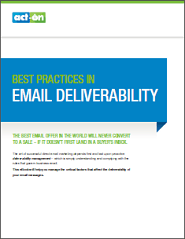 “Deliverability” is the term used to describe the success rate for delivering email into subscribers’ inboxes. The business processes and reputation of an email service provider affect deliverability, but the email marketing team has control over the most critical deliverability factors, regardless of which email marketing solution is used.
“Deliverability” is the term used to describe the success rate for delivering email into subscribers’ inboxes. The business processes and reputation of an email service provider affect deliverability, but the email marketing team has control over the most critical deliverability factors, regardless of which email marketing solution is used.
This glossary defines the most common terms that the email marketer should be familiar with, in order to manage the many components of deliverability.
It’s long, so we’re running it in two parts. Look for Part 2 next week.
Term |
Definition |
| Authentication | Email authentication allows a sender to verify their legitimate identity to a receiving mail server by providing a record of identification to check. The most common forms of authentication are DKIM (Domain Keys Identified Mail) and SPF (Sender Policy Framework). |
| B2B | Business-to-Business: This term applies to doing business with (including sending email to) commercial entities and their employees. |
| B2C | Business to Consumer: This term applies to doing business with (including sending email to) consumers, usually at consumer email addresses, most often at Internet Service Providers (ISPs) such as Gmail, Comcast, AOL, Yahoo, etc.). |
| Blacklists | Lists that log the IP sending addresses and domains of senders whose emails can be denied due to factors such as reputation, spam complaints, etc. Receiving email servers use blacklists to prevent spam and other unwanted mail (from specific senders) from reaching the intended recipient. |
| Blocks | “Blocking” is an action taken by receiving servers and ISPs to stop incoming email from reaching the intended recipient. Along with blacklists, ISPs use filters to identify unwanted email. One example is a content filter, which looks for certain words or phrases used anywhere in the email. This type of blocking occurs on a per-email basis, not a sender basis. It is typically used by corporate networks. |
| Bounce | An email that “bounces back” (is automatically returned) to the sender as undelivered and/or undeliverable. See “Hard Bounce” and “Soft Bounce”. |
| Bulking | This term refers to email that is collected (“bulked”) and placed in the spam folder, rather than showing up in the recipient’s inbox. |
| CAN-SPAM | The CAN-SPAM Act of 2003 is the United States law of the land governing commercial email messages. Among other criteria, it gives recipients the right to have you stop emailing them, and spells out tough penalties for violations. Learn more. |
| CASL | The Canadian Anti-Spam Legislation establishes provisions and standards for all electronic messages, including email, SMS, voice, IMs, and social media in Canada. It is more restrictive than the American law, particularly in the area of express consent. Learn more. |
| Clickthough Rate | For a given sent email, the percentage of recipients that interact (beyond just opening the email), such as clicking links, images, etc. |
| Compliance | Adhering to email laws and delivery best practices. If you send email to multiple countries, you will need to be in compliance with the specific email-related legalities of each country. |
| Consent | This is the permission an email recipient gives for a sender to contact them via email. In express consent, the subscriber clearly opts to receive your emails. In implied consent, you have a relationship with them (perhaps they bought something from your company) but they have not explicitly signed up or opted in to receive your emails. Learn more about express and implied consent. |
| Data Hygiene | The process of keeping data clean and up to date. Unmaintained or outdated data is known to cause deliverability issues. |
| Dedicated IP | A unique Internet Protocol address which is used specifically for one particular sender and host. This is in opposition to a Shared IP, in which different email senders may send from the same IP address, thus affecting each other’s deliverability rates. |
| Delivered | The amount of emails that were delivered to the intended recipient’s server, excluding blocks and bounces. |
| Deliverability | The percentage of mail delivered that makes it to the recipient’s inbox versus the spam folder. |
| DKIM | Domain Keys Identified Mail is a common form of authentication. It provides a method by which a receiving email server can validate the domain name identity that is associated with a message. It is implemented by marketers for the domain being used in the “From” address of the emails going out, but authenticated by global receivers and ISPs upon inbound of the traffic to their servers. |
| DMARC | Domain Based Message Authentication, Reporting, and Conformance is a new form of authentication, established in 2012, that expands on DKIM and SPF. DMARC further pushes the forms of authentication to new levels in an effort to further combat fraudulent emails. To pass DMARC signing, the SPF and DKIM must match what is set up in the DNS of a domain. If not, options are established to determine by the signing party what to do with the mailing. Signing parties can also get reports that provide more details into who might be trying to send on their behalf (a.k.a. spoofing or phishing.) |
| Double Opt-In | This is a tactic that helps build a healthy email list. The subscriber checks a box or fills in information, giving their consent to be mailed to. That’s “opt-in.” Then the recipient is sent a confirmation email, and must click a link (the second, or “double”, opt-in) to confirm their consent to receive emails. |
| Email Performance Factors | A set of factors (sent, delivered, opened, clicked) that make up overall performance. |
| Engaged | Recipients who have actively opened, clicked, and interacted with emails in the past. The time period could vary, but 180 days is a best practice recommendation. |
| Envelope | Think of email as analogous to a real-life mail item. As the sender, on the envelope, you specify where you want the package sent (the “To” address), who it comes from (the “From” address, which may be an alias for the sending address) and where it should be returned if it could not be delivered (the “Return Path”). |
| European Union (EU) Anti-Spam Laws | A set of laws and procedures that are specific to marketers sending email to the various countries in the European Union. See Act-On’s The EU Data Protection Overview for details by country. |
| Feedback Loop | This is a process for reporting recipient and spam complaints to the sending organization. |
| “From” Address | The email address that is visible to the recipient. It may be an alias for an actual sending address. It may also be different from the “Reply to” email address. |
| Hard Bounce | A type of bounce that indicates a permanent technical problem with the recipient’s address; it may not exist, or it may be incorrectly formatted. As opposed to a “Soft Bounce,” which indicates a temporary technical problem with delivering the email (such as a short-term connection failure). |
| Honeypot | A decoy email address used to attract and identify spammers who scrape and harvest addresses. |
| HTML | Hypertext Mark-Up Language. A standard markup language used to create web pages, emails, and more. It can display both text and images. |
| IPR (inbox placement rate) | The rate at which emails to recipients go straight to the inbox without being filtered out or blocked. |
| List Cleanse | A service to rid sending lists of possible spam traps, incorrectly formatted email addresses, etc. |
| List Validation | A service that verifies that the email addresses on a list are valid and live at a specific point in time. |
| NDR | Non-Delivery Reports are generated by mail servers, and show an email sender the reason(s) why an email fails in delivery. The associated data can include date and time, details of the mail server, and details of the bounced message (e.g. sender, recipient, subject). |
| Open Rate | For any given sent email, the rate at which email recipients open the message. The open rate may not accurately reflect whether a recipient actually viewed the email (e.g., an email viewed in the preview pane is not considered “opened”). In addition, open rates are typically tracked using a transparent 1×1 pixel, or small transparent tracking image. If the recipient’s email client disables images by default, the open is not tracked. |
| Opt-Outs | When a subscriber informs you that they no longer want to receive your email, typically by clicking an “unsubscribe” link in your email. They must always have this option, otherwise you are not in accordance with law. |
Stay tuned for Part 2 of Act-On’s Deliverability Glossary next week!
 The art of successful email marketing depends first and last upon proactive deliverability management. Download the white paper, Best Practices in Email Deliverability, and learn the best practices for how to manage the critical factors that affect the deliverability of your email messages.
The art of successful email marketing depends first and last upon proactive deliverability management. Download the white paper, Best Practices in Email Deliverability, and learn the best practices for how to manage the critical factors that affect the deliverability of your email messages.
You will learn about what email service providers look for, SPAM facts, the key factors that affect your sender reputation, best practices for retention and acquisition, and so much more!
